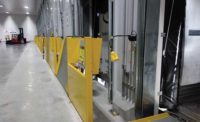One word can easily describe the year organizations in the food, restaurant and grocery industries have had in 2020: Change.
What began as a promising 2020 quickly was turned upside down in late February as COVID-19 lockdowns swept across the country overnight forcing many restaurants to close their doors, while grocers and food delivery services had to immediately handle a surge in demand.
Distributors Faced Early 2020 Challenges
Refrigerated foods distributors were caught in the middle of all this, forcing some with a heavy portfolio of restaurant clients to either scale their fleets or pivot their business strategies to handle the increased demand for grocery deliveries and e-commerce-driven orders. And if the business strategy and logistics didn’t prove challenging enough, new social distancing and health/cleanliness guidelines added to the pressure.
According to a recent survey of transportation fleet executives1, approximately 13% of fleets said they altered their truck utilization to accommodate more grocery deliveries during the COVID-19 pandemic. Another 32%, roughly a third, said they needed to change routes for at least some trucks in their fleet.
Many organizations found themselves needing to scale down their fleets because of the downturn in business activity. More than a quarter of executives polled1 (27%) said they downsized their fleets, and new industry programs were introduced2 to help organizations scale their fleets accordingly while infusing much-needed cash into their operations.
Restaurants were among the hardest-hit businesses in the industry, and the ripple effects spread to their distribution partners. It is estimated that there are 11 million people working for independent restaurants across the U.S., and 85% of them may not keep their jobs this year3. In the same survey, fleet executives were asked what has been the most significant challenge to operations since the beginning of the COVID-19 pandemic. Companies in the food and restaurant distribution space noted a reduction in customer volumes led to a reduction in miles driven, and overall sales. Naturally, another concern was the health and safety of the truck drivers themselves.
Shifting Dynamics Between Grocery Stores and Restaurants
As the pandemic has made its way toward the end of the year, some of this has again shifted, with grocery/food delivery sales slipping a little and restaurant sales increasing from their lows as states continue with their reopening plans.
Food and beverage sales at U.S. retail and grocery stores grew 11.5% in August compared with last year, according to data provided by Nielsen. This compares with 31.2% year-over-year growth that was reported back in March when the pandemic first hit. Furthermore, sales online have also begun to moderate slightly. Delivery and curbside pickup sales totaled $5.7 billion in August, down from $6.6 billion in May and $7.2 billion in June as reported by the consulting firm Brick Meets Click4.
However, the distribution industry continues to show its resiliency and companies with transportation fleets have learned to be agile during the pandemic to accommodate more e-commerce business through traditional channels such as B2B and B2C, and a growing channel of manufacturers direct to consumers.
Self-Distribution Offers Business Agility
As a result, some organizations are placing a larger emphasis on private fleet operations to better-control costs and have the ability to adapt quicker to business climate changes. For example, next year, Ahold Delhaize USA says it will transition six facilities under its three-year initiative to switch to a fully-integrated, self-distribution model driven by its own private fleet. With the transition of the six facilities in 2021, about 65% of Ahold Delhaize USA brand center-store volume will be self-distributed. In late 2019, the company unveiled a three-year, $480 million plan to expand its supply chain operations and shift to a self-distribution model, which includes e-commerce channels.
Private fleet operations, combined with the shift to a shorter life cycle cost management strategy have enabled these organizations to increase operational efficiencies and reduce overall costs to their bottom line through lower fuel, maintenance, and safety expenditures, as well as a reduction in greenhouse gas emissions.
Amazon Now a Logistics Powerhouse
While B2B and B2C have begun to leverage more e-commerce, the rise of direct-to-consumer has exploded this year driven partly by the pandemic. Most notably, Amazon is almost as known as a logistics provider as it is a retailer today, and it recently unveiled plans for more than 1,000 small delivery hubs launching across the U.S. The company ultimately hopes to open around 1,500 hubs each in suburbs and cities across the country in the future, giving consumers direct access to their favorite suppliers with quick shipping and delivery methods driven by e-commerce.
If 2020 has proven anything, it is that companies with the flexibility to change quickly and adapt through operational efficiencies and e-commerce-driven strategies will be expertly positioned as we enter 2021, even in what are still unprecedented and uncertain times.
REFERENCES
- Fleet Advantage COVID-19 Truck Utilization Survey, August 2020, presented to 1,500 truck fleet executives across the U.S.
- https://www.fleetadvantage.com/press-releases/fleet-advantage-unveils-sale-leaseback-program-designed-to-infuse-cash-flexibility-for-transportation-fleets
- https://www.washingtonpost.com/health/2020/09/14/covid-spread-restaurants-bars/?arc404=true
- https://www.cnn.com/2020/09/14/business/grocery-store-kroger-walmart-costco/index.html




